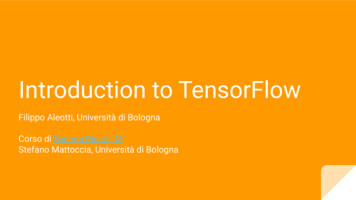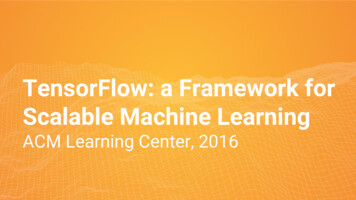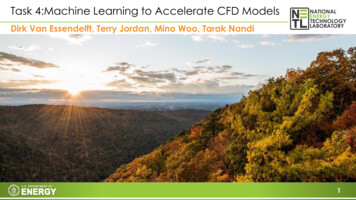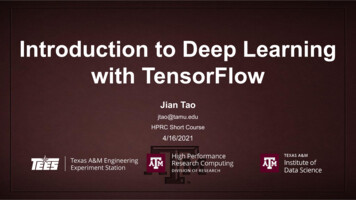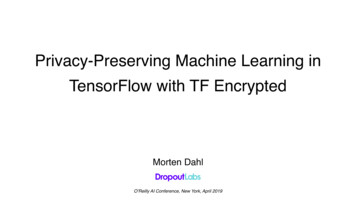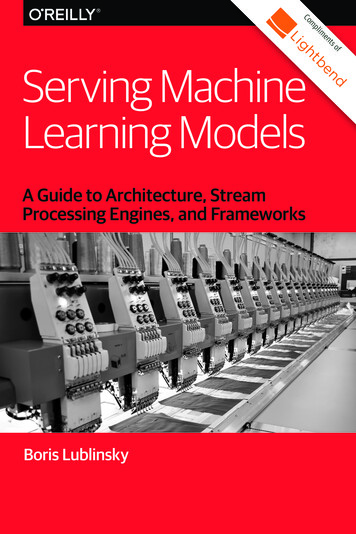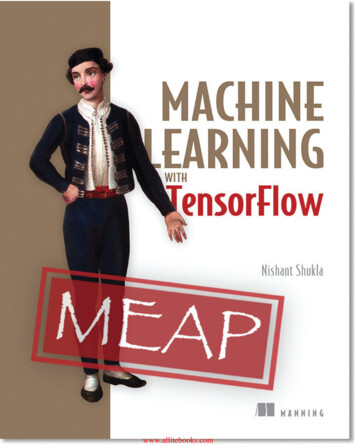
Transcription
www.allitebooks.com
MEAP EditionManning Early Access ProgramMachine Learning with TensorFlowVersion 10Copyright 2017 Manning PublicationsFor more information on this and other Manning titles go towww.manning.com Manning Publications Co. We welcome reader comments about anything in the manuscript - other than typos andother simple mistakes. These will be cleaned up during production of the book by copyeditors and hine-learning-with-tensorflowwww.allitebooks.com
welcomeDear fellow early adopters, curious readers, and puzzled newcomers,Thank you all for every bit of communication with me, whether it be through the officialbook forums, through email, on GitHub, or even on Reddit. I’ve listened carefully to yourquestions, suggestions, and concerns, regardless of whether or not I’ve replied to you (and Ido apologize for not replying to you).In the latest edition, I am proud to announce a beautiful makeover of every chapter. Thetext is greatly improved and slowed down to better cover complex matters, especially theareas where you requested more explanation. Most figures and mathematical equations havebeen updated to look crisp and professional. The code is now updated to TensorFlow v1.0, andit is also available on GitHub at https://github.com/BinRoot/TensorFlow-Book/. Also, thechapters are rearranged to better deliver the right skills at the right time, if the book wereread in order.Thank you for investing in the MEAP edition of Machine Learning with TensorFlow. You’reone of the first to dive into this introductory book about cutting-edge machine learningtechniques using the hottest technology (spoiler alert: I’m talking about TensorFlow). You’re abrave one, dear reader. And for that, I reward you generously with the following.You’re about to learn machine learning from scratch, both the theory and how to easilyimplement it. As long as you roughly understand object-oriented programming and know howto use Python, this book will teach you everything you need to know to start solving your ownbig-data problems, whether it be for work or research.TensorFlow was released just over a year ago by some company that specializes in searchengine technology. Okay, I’m being a little facetious; well-known researchers at Googleengineered this library. But with such prowess comes intimidating documentation andassumed knowledge. Fortunately for you, this book is down-to-earth and greets you with openarms.Each chapter zooms into a prominent example of machine learning, such as classification,regression, anomaly detection, clustering, and many modern neural networks. Cover them allto master the basics, or cater it to your needs by skipping around.Keep me updated on typos, mistakes, and improvements because this book is undergoingheavy development. It’s like living in a house that’s still actively under construction; at leastyou won’t have to pay rent. But on a serious note, your feedback along the way will beappreciated.With gratitude,—Nishant Shukla Manning Publications Co. We welcome reader comments about anything in the manuscript - other than typos andother simple mistakes. These will be cleaned up during production of the book by copyeditors and hine-learning-with-tensorflowwww.allitebooks.com
brief contentsPART 1 MY MACHINE LEARNING RIG1 A machine learning odyssey2 TensorFlow essentialsPART 2 CORE LEARNING ALGORITHMS3 Linear regression and beyond4 A gentle introduction to classification5 Automatically clustering data6 Hidden Markov modelsPART 3 THE NEURAL NETWORK PARADIGM7 A peek into autoencoders8 Reinforcement learning9 Convolutional neural networks10 Recurrent neural networks11 Sequence-to-sequence models for chatbots12 Utility landscapeAPPENDIXA Installation Manning Publications Co. We welcome reader comments about anything in the manuscript - other than typos andother simple mistakes. These will be cleaned up during production of the book by copyeditors and hine-learning-with-tensorflowwww.allitebooks.com
11A machine-learning odysseyThis chapter covers Machine learning fundamentals Data representation, features, and vector norms Existing machine learning tools Why TensorFlowHave you ever wondered if there are limits to what computer programs can solve?Nowadays, computers appear to do a lot more than simply unravel mathematical equations. Inthe last half-century, programming has become the ultimate tool to automate tasks and savetime, but how much can we automate, and how do we go about doing so?www.allitebooks.com
2Can a computer observe a photograph and say “ah ha, I see a lovely couple walking over abridge under an umbrella in the rain?” Can software make medical decisions as accurately asthat of trained professionals? Can software predictions about the stock market perform betterthan human reasoning? The achievements of the past decade hint that the answer to all thesequestions is a resounding “yes,” and the implementations appear to share a common strategy.Recent theoretic advances coupled with newly available technologies have enabled anyonewith access to a computer to attempt their own approach at solving these incredibly hardproblems. Okay, not just anyone, but that’s why you’re reading this book, right?A programmer no longer needs to know the intricate details of a problem to solve it.Consider converting speech to text: a traditional approach may involve understanding thebiological structure of human vocal chords to decipher utterances using many hand-designed,domain-specific, un-generalizable pieces of code. Nowadays, it’s possible to write code thatsimply looks at many examples, and figures out how to solve the problem given enough timeand examples.The algorithm learns from data, similar to how humans learn from experiences. Humanslearn by reading books, observing situations, studying in school, exchanging conversations,browsing websites, among other means. How can a machine possibly develop a brain capableof learning? There’s no definitive answer, but world-class researchers have developedintelligent programs from different angles. Among the implementations, scholars have noticedrecurring patterns in solving these kinds of problems that has led to a standardized field thatwe today label as machine learning (ML).As the study of ML matures, the tools have become more standardized, robust, performant,and scalable. This is where TensorFlow comes in. It’s a software library with an intuitiveinterface that lets programmers dive into using complex ML ideas. The next chapter will gothrough the ins and outs of this library, and every chapter thereafter will explain how to useTensorFlow for each of the various ML applications.Trusting machine learning outputDetecting patterns is a trait that’s no longer unique to humans. The explosive growth of computer clock-speed andmemory has led us to an unusual situation: computers now can be used to make predictions, catch anomalies, rankitems, and automatically label images. This new set of tools provides intelligent answers to ill-defined problems, but atthe subtle cost of trust. Would you trust a computer algorithm to dispense vital medical advice such as whether toperform heart surgery?There is no place for mediocre machine learning solutions. Human trust is too fragile, and our algorithms must berobust against doubt. Follow along closely and carefully in this chapter.1.1 Machine learning fundamentalsHave you ever tried to explain to someone how to swim? Describing the rhythmic jointmovements and fluid patterns is overwhelming in its complexity. Similarly, some softwarewww.allitebooks.com
3problems are too complicated for us to easily wrap our minds around. For this, machinelearning may be just the tool to use.Hand-crafting carefully tuned algorithms to get the job done was once the only way ofbuilding software. From a simplistic point of view, traditional programming assumes adeterministic output for each of its input. Machine learning, on the other hand, can solve aclass of problems where the input-output correspondences are not well understood.Full speed ahead!Machine learning is a relatively young technology, so imagine you're a geometer in Euclid's era, paving the way to anewly discovered field. Or, treat yourself as a physicist during the time of Newton, possibly pondering somethingequivalent to general relativity for the field of machine learning.Machine Learning is about software that learns from previous experiences. Such a computerprogram improves performance as more and more examples are available. The hope is that ifyou throw enough data at this machinery, it will learn patterns and produce intelligent resultsfor newly fed input.Another name for machine learning is inductive learning, because the code is trying to inferstructure from data alone. It’s like going on vacation in a foreign country, and reading a localfashion magazine to mimic how to dress up. You can develop an idea of the culture fromimages of people wearing local articles of clothing. You are learning inductively.You might have never used such an approach when programming before because inductivelearning is not always necessary. Consider the task of determining whether the sum of twoarbitrary numbers is even or odd. Sure, you can imagine training a machine learning algorithmwith millions of training examples (outlined in Figure 1.1), but you certainly know that'soverkill. A more direct approach can easily do the trick.Figure 1.1 Each pair of integers, when summed together, results in an even or odd number. The input and outputcorrespondences listed are called the ground-truth dataset.For example, the sum of two odd numbers is always an even number. Convince yourself:take any two odd numbers, add them up, and check whether the sum is an even number.Here’s how you can prove that fact directly:www.allitebooks.com
4For any integer n, the formula 2n 1 produces an odd number. Moreover, any odd numbercan be written as 2n 1 for some value n. So the number 3 can be written 2(1) 1. Andthe number 5 can be written 2(2) 1.So, let's say we have two different odd numbers 2n 1 and 2m 1, where n and m areintegers. Adding two odd numbers together yields (2n 1) (2m 1) 2n 2m 2 2(n m 1). This is an even number because 2 times anything is even.Likewise, we see that the sum of two even numbers is also an even number: 2m 2n 2(m n). And lastly, we also deduce that the sum of an even with an odd is an odd number: 2m (2n 1) 2(m n) 1. Figure 1.2 visualizes this logic more clearly.Figure 1.2 This table reveals the inner logic behind how the output response corresponds to the input pairs.That's it! With absolutely no use of machine learning, you can solve this task on any pair ofintegers someone throws at you. Simply applying mathematical rules directly can solve thisproblem. However, in ML algorithms, we can treat the inner logic as a black box, meaning thelogic happening inside might not be obvious to interpret.www.allitebooks.com
5Figure 1.3 An ML approach to solving problems can be thought of as tuning the parameters of a black box until itproduces satisfactory results.PARAMETERSSometimes the best way to devise an algorithm that transforms an input to itscorresponding output is too complicated. For example, if the input were a series of numbersrepresenting a grayscale image, you can imagine the difficulty in writing an algorithm to labelevery object seen in the image. Machine learning comes in handy when the inner workings arenot well understood. It provides us with a toolset to write software without adequately definingevery detail of the algorithm. The programmer can leave some values undecided and let themachine learning system figure out the best values by itself.The undecided values are called parameters, and the description is referred to as themodel. Your job is to write an algorithm that observes existing examples to figure out how tobest tune parameters to achieve the best model. Wow, that’s a mouthful! Don’t worry, thisconcept will be a reoccurring motif.Machine learning might solve a problem without much insightBy mastering this art of inductive problem solving, we wield a double-edged sword. Although ML algorithms mayappear to answer correctly to our tests, tracing the steps of deduction to reason why a result is produced may not be asimmediate. An elaborate machine learning system learns thousands of parameters, but untangling the meaning behindeach parameter is sometimes not the prime directive. With that in mind, I assure you there's a world of magic to unfold.EXERCISE Suppose you’ve collected three months-worth of stock market prices. You would like to predictfuture trends to outsmart the system for monetary gains. Without using ML, how would you go about solvingthis problem? (As we’ll see in chapter 8, this problem becomes approachable using ML techniques.)LEARNING AND INFERENCESuppose you’re trying to bake some desserts in the oven. If you’re new to the kitchen, itcan take days to come up with both the right combination and perfect ratio of ingredients towww.allitebooks.com
6make something that tastes great. By recording recipes, you can remember how to quicklyrepeat the dessert if you happen to discover the ultimate tasting meal.Similarly, machine learning shares this idea of recipes. Typically, we examine an algorithmin two stages: learning and inference. The objective of the learning stage is to describe thedata, which is called the feature vector, and summarize it into a model. The model is ourrecipe. In effect, the model is a program with a couple of open interpretations, and the datahelps disambiguate it.WHAT IS A FEATURE VECTOR? A feature vector is a practical simplification of data. You can think ofit as a sufficient summary of real-world objects into a list of attributes. The learning and inference steps rely onthe feature vector instead of the data directly.Similar to how recipes can be shared and used by other people, the learned model is alsoreused by other software. The learning stage is the most time-consuming. Running analgorithm may take hours, if not days or weeks, to converge into a useful model. Figure 1.4outlines the learning pipeline.Figure 1.4 The general learning approach follows a structured recipe. First, the dataset needs to be transformedinto a representation, most often a list of vectors, which can be used by the learning algorithm. The learningalgorithm choses a model and efficiently searches for the model’s parameters.The inference stage uses the model to make intelligent remarks about never-before-seendata. It’s like using a recipe you found online. The process typically takes orders of magnitudeless time than learning, sometimes even being real-time. Inference is all about testing themodel on new data, and observing performance in the process, as shown in figure 1.5.Figure 1.5 The general inference approach uses a model that has already been either learned or simply given.After converting data to a usable representation, such as a feature vector, it uses the model to produce intendedwww.allitebooks.com
7output.1.2 Data representation and featuresData is the first-class citizen of machine learning. Computers are nothing more thansophisticated calculators, and so the data we feed our machine learning systems must bemathematical objects, such as (1) vectors, (2) matrices, or (3) graphs.The basic theme in all forms of representation is the idea of features, which are observableproperties of an object.1.Vectors have a flat and simple structure and are the typical embodiment of data inmost real-world machine learning applications. They have two attributes: a naturalnumber representing the dimension of the vector, and a type (such as realnumbers, integers, and so on). Just as a refresher, some examples of 2-dimensionvectors of integers are (1,2) or (-6,0). Some examples of 3-dimension vectors ofreal numbers are (1.1, 2.0, 3.9) or (π, π/2, π/3). You get the idea, just a collectionof numbers of the same type. In a machine learning program, a vector measures aproperty of the data, such as color, density, loudness, or proximity – anything youcan describe with a series of numbers, one for each thing being measured.2.Moreover, a vector of vectors is a matrix. If each feature vector describes thefeatures of one object in your data set, the matrix describes all the objects – eachitem in the outer vector is a node that’s a list of features of one object.3.Graphs, on the other hand, are more expressive. A graph is a collection of objects(i.e. nodes) that can be linked together with edges to represent a network. Agraphical structure enables representing relationships between objects, such as ina friendship network or a navigation route of a subway system. Consequently, theyare tremendously harder to manage in machine learning applications. In this book,our input data will rarely involve a graphical structure.Feature vectors are a practical simplification or real-world data, which can be toocomplicated to deal with in the real world. Instead of attending to every little detail of a dataitem, a feature vector is a practical simplification. For example, a car in the real-world is muchmore than the text used to describe it. A car salesman is trying to sell you the car, not theintangible words spoken or written. Those words are just abstract concepts, very similar to howfeature vectors are just summaries of the data.The following scenario will help explain this further. When you're in the market for a newcar, keeping tabs on every minor detail between different makes and models is essential. Afterall, if you're about to spend thousands of dollars, you may as well do so diligently. You wouldlikely record a list of features about each car and compare them back and forth. This orderedlist of features is the feature vector.When buying cars, comparing mileage might be more lucrative than comparing somethingless relevant to your interest, such as weight. The number of features to track also must be
8just right, not too few, or you’ll be losing information you care about, and not too many, or itwill be unwieldy and time-consuming to keep track of. This tremendous effort to select both thenumber of measurements and which measurements to compare is called feature engineering.Depending on which features you examine, the performance of your system can fluctuatedramatically. Selecting the right features to track can make up for a weak learning algorithm.For example, when training a model to detect cars in an image, you will gain an enormousperformance and speed improvement if you first convert the image to grayscale. By providingsome of your own bias into the preprocessing of the data, you end up helping the algorithmbecause it will not need to learn that colors don’t quite matter when detecting cars. Thealgorithm can instead focus on identifying shapes and textures, which may will lead to muchfaster learning than trying to process colors as well.The general rule of thumb in ML is that more data produces better results. However, thesame is not always true for having more features. Perhaps counterintuitive, if the number offeatures you’re tracking is too high, then it may hurt performance. Scholars call thisphenomenon the curse of dimensionality. Populating the space of all data with representativesamples requires exponentially more data as the dimension of the feature vector increases. Asa result, feature engineering is one of the most important problems in ML.Curse of dimensionalityIn order to accurately model real-world data, we clearly need more than just 1 or 2 data points. But just how muchdata depends on a variety of things, including the number of dimensions in the feature vector. Adding too many featurescauses the number of data points required to describe the space to increase exponentially. That’s why you can’t justdesign a 1,000,000 dimensional feature vector to exhaust all possible factors and then expect the algorithm to learn amodel. This phenomena is called the curse of dimensionality.Figure 1.6 Feature engineering is the process of selecting relevant features for the task.
9You may not appreciate it immediately, but something consequential happens when youdecide which features are worth observing. For centuries, philosophers have pondered themeaning of identity; you may not immediately realize this, but you've come up with a definitionof identity by your choice of specific features.Imagine writing a machine learning system to detect faces in an image. Let's say one of thenecessary features for something to be a face is the presence of two eyes. Implicitly, a face isnow defined as something with eyes. Do you realize what types of trouble this can get us into?If a photo of a person shows him or her blinking, then our detector will not find a face becauseit couldn’t find two eyes. The algorithm would fail to detect a face when a person is blinking.The definition of a face was inaccurate to begin with, and it's apparent from the poor detectionresults.The identity of an object is decomposed into the features from which it’s composed. Forexample, if the features you are tracking of one car exactly match the corresponding featuresof another car, they may as well be indistinguishable from your perspective. We’d need to addanother feature to the system in order to tell them apart, or we think they are the same item.When hand-crafting features, we must take great care not to fall into this philosophicalpredicament of identity.EXERCISE Let's say you're teaching a robot how to fold clothes. The perception system sees a shirt lying ona table (figure 1.7). You would like to represent the shirt as a vector of features so you can compare it withdifferent clothes. Decide which features would be most useful to track. (Hint: what types of words do retailersuse to describe their clothing online?)Figure 1.7 A robot is trying to fold a shirt. What are good features of the shirt to track?
10EXERCISE Now, instead of detecting clothes, you ambitiously decide to detect arbitrary objects. What aresome salient features that can easily differentiate objects?Figure 1.8 Here are images of three objects: a lamp, a pair of pants, and a dog. What are some good featuresthat you should record to compare and differentiate objects?Feature engineering is a refreshingly philosophical pursuit. For those who enjoy thoughtprovoking escapades into the meaning of self, I invite you to meditate on feature selection, asit is still an open problem. Fortunately for the rest of you, to alleviate extensive debates, recentadvances have made it possible to automatically determine which features to track. You will beable to try it out for yourself in the chapter 8 about autoencoders.Feature vectors are used in both learning and inferenceThe interplay between learning and inference is the complete picture of a machine learning system, as seen in figure1.9. The first step is to represent real-world data into a feature vector. For example, we can represent images by a vectorof numbers corresponding to pixel intensities (We’ll explore how to represent images in greater detail in future chapters).We can show our learning algorithm the ground truth labels (such as “Bird” or “Dog”) along with each feature vector.With enough data, the algorithm generates a learned model. We can use this model on other real-world data to uncoverpreviously unknown labels.
11Figure 1.9 Feature vectors are a representation of real world data used by both the learning and inferencecomponents of machine learning. The input to the algorithm is not the real-world image directly, but instead itsfeature vector.1.3 Distance MetricsIf you have feature vectors of potential cars you want to buy, you can figure out which twoare most similar by defining a distance function on the feature vectors. Comparing similaritiesbetween objects is an essential component of machine learning. Feature vectors allow us torepresent objects so that they we may compare them in a variety of ways. A standardapproach is to use the Euclidian distance, which is the geometric interpretation you may findmost intuitive when thinking about points in space.Let's say we have two feature vectors, x (x1, x2, , xn) and y (y1, y2, , yn). TheEuclidian distance x-y is calculated by
12For example, the Euclidian distance between (0, 1) and (1, 0) isScholars call this the L2 norm. But that’s actually just one of many possible distancefunctions. There also exists L0, L1, and L-infinity norms. All of these norms are a valid way tomeasure distance. Here they are in more detail: The L0 norm counts the total number of non-zero elements of a vector. For example,the distance between the origin (0, 0) and vector (0, 5) is 1, because there is only 1non-zero element. The L0 distance between (1,1) and (2,2) is 2, because neitherdimension matches up. Imagine if the first and second dimensions represent usernameand password, respectively. If the L0 distance between a login attempt and the truecredentials is 0, then the login is successful. If the distance is 1, then either theusername or password is incorrect, but not both. Lastly if the distance is 2, bothusername and password are not found in the database. The L1 norm is defined as Σ xn . The distance between two vectors under the L1 norm isalso referred to as the Manhattan distance. Imagine living in a downtown area likeManhattan, New York, where the streets form a grid. The shortest distance from oneintersection to another is along the blocks. Similarity, the L1 distance between twovectors is along the orthogonal directions. So the distance between (0, 1) and (1, 0)under the L1 norm is 2. Computing the L1 distance between two vectors is essentiallythe sum of absolute differences at each dimension, which is a useful measure ofsimilarity.Figure 1.10 The L1 distance is also called the taxi-cab distance because it resembles the route of a car in a gridlike neighborhood such as Manhattan. If a car is travelling from point (0,1) to point (1,0), the shortest routerequires a length of 2 units.
13 The L2 norm is the Euclidian length of a vector, (Σ(xn)2)1/2. It is the most direct routeone can possibly take on a geometric plane to get from one point to another. For themathematically inclined, this is the norm that implements the least square estimation aspredicted by the Gauss-Markov theorem. For the rest of you, it’s the shortest distancebetween two points in space.Figure 1.11 The L2 norm between points (0,1) and (1,0) is the length of a single straight line segment reachingboth points. The L-N norm generalizes this pattern, resulting in (Σ xn N)1/N. We rarely use finitenorms above L2, but it’s here for completeness. The L-infinity norm is (Σ xn )1/ . More naturally, it is the largest magnitude amongeach element. If the vector is (-1, -2, -3), the L-infinity norm will be 3. If a featurevector represents costs of various items, then minimizing the L-infinity norm of thevector is an attempt to reduce the cost of the most expensive item.When do I use a metric other than the L2 norm in the real-world?Let’s say you’re working for a new search-engine start-up trying to compete with Google. Your boss assigns you thetask of using machine learning to personalize the search results for each user.A good goal might be that users shouldn’t see five or more incorrect search-results per month. A year’s worth of userdata is a 12-dimension vector (where each month of the year is a dimension), indicating number of incorrect resultsshown per month. You are trying to satisfy the condition that the L-infinity norm of this vector must less than 5.Suppose instead that your boss changes his/her mind and requires that less than 5 erroneous search-results areallowed for the entire year. In this case, you are trying to achieve a L1 norm below 5, because the sum of all errors in theentire space should be less than 5.Actually, your boss changes his or her mind again. Now, the number of months with erroneous search-results shouldbe less than 5. In that case, you are trying to achieve an L0 norm below 5, because the number of months with a nonzero error should be less than 5.
141.4 Types of LearningNow that we can compare feature vectors, we have the tools necessary to use data forpractical algorithms. Machine learning is often split into three perspectives: supervisedlearning, unsupervised learning, and reinforcement learning. Let's examine each, one by one.1.4.1Supervised LearningBy definition, a supervisor is someone higher up in the chain of command. When in doubt,he or she dictates what to do. Likewise, supervised learning is all about learning from exampleslaid out by a "supervisor" (such as a leddatatodevelopausefulunderstanding, which we call its model. For example, given many photographs of people andtheir recorded corresponding ethnicity, we can train a model to classify the ethnicity of anever-before-seen individual in an arbitrary photograph. Simply put, a model is a function thatassigns a label to some data. It does so by using previous examples, called a training dataset,as reference.A convenient way to talk about models is through mathematical notation. Let x be aninstance of data, such as a feature vector. The corresponding label associated with x is f(x),often referred to as the ground truth of x. Usually, we use the variable y f(x) because it’squicker to write. In the example of classifying the ethnicity of a person through a photograph, xcan be a hundred-dimensional vector of various relevant features, and y is one of a couplevalues to represent the various ethnicities. Since y is discrete with few values, the model iscalled a classifier. If y could result in many values, and the values have a natural o
TensorFlow for each of the various ML applications. Trusting machine learning output Detecting patterns is a trait that’s no longer unique to humans. The explosive growth of compu ter clock-speed and memory has led us to an unusual situation: computers n
